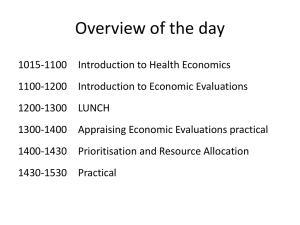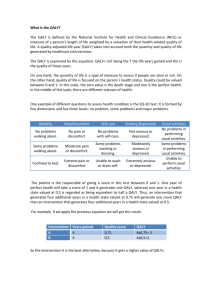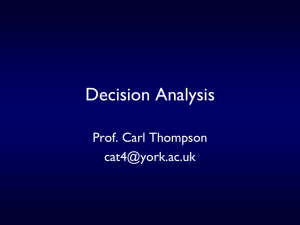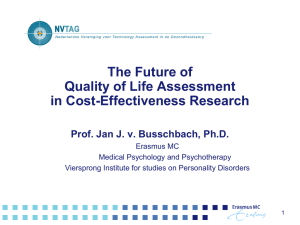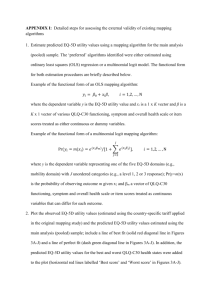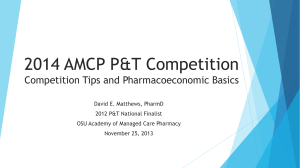Measuring and valuing health out comes
advertisement
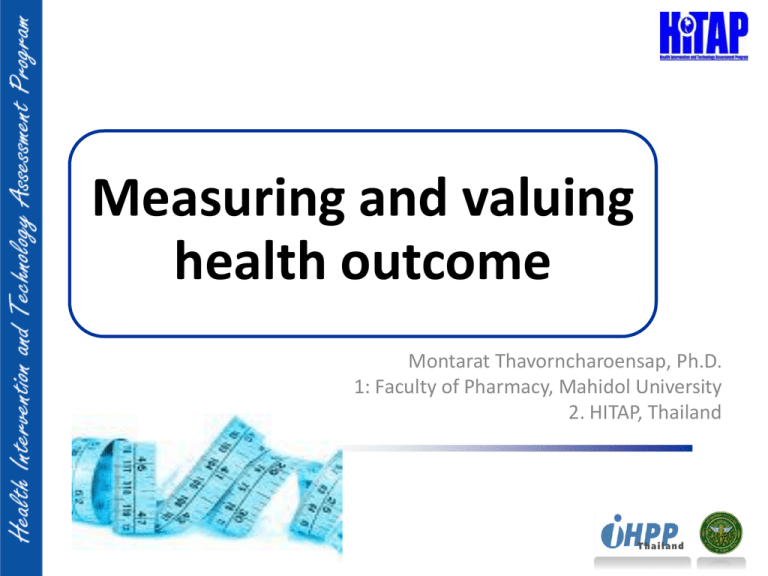
Measuring and valuing health outcome Montarat Thavorncharoensap, Ph.D. 1: Faculty of Pharmacy, Mahidol University 2. HITAP, Thailand Outline Types of outcome used in health economic evaluation Outcome measure in CEA Outcome measure in CUA • Quality Adjusted Life Year (QALY) • Methods for assessing utility value (VAS, SG, TTO, EQ-5D) 2 Economic Evaluation Cost $$ Outcome Definition: The comparative analysis of alternative courses of action in terms of both their costs and consequences (outcome). Drummond et al 2005 Type of economic evaluation Cost-minimization Cost-effectiveness Cost-utility Cost-benefit Nominator Denominator (Cost) (Outcome) $ $ Clinical outcome in natural unit e.g. # of death prevented, # of fracture prevented, # of abstinent participants, # of quit attempt $ Outcome in a common unit e.g. QALY 4 $ $ Economic evaluation Cost $$ Outcome Cost-effectiveness analysis Drug A Drug B Cost (Baht) Outcome 1,000 Quite rate = 10% 2,000 Quite rate = 20% Cost analysis Outcome assessment Outcome measure plays an important role in the validity of health technology assessment results. Outcome used for HTA should be measured from the relevant sample with proper study design and method. 6 Outcome measure in cost-effectiveness analysis VS P.7 Unit of outcome measurement in cost-effectiveness analysis Clinical outcome in natural unit • # of abstinent participants • # of quit attempt 8 Efficacy VS Effectiveness Efficacy: A clinical outcome derived from patients’ use of pharmaceutical product or health technology, typically Randomized Control trial Phase III. Main concern is validity. “Can it work under ideal conditions?” Effectiveness: How well a treatment or health technology performs under real world conditions outside the context of a randomised trial where the experiment no longer hold. Main concern is generalizability or transferability. “Does it work under real circumstances?” 9 Efficacy VS Effectiveness According to the website, “Pharmacoeconomic Guidelines Around the World” by ISPOR, 23 out of 32 guidelines clearly indicated that health outcome should be measured in term of effectiveness instead of efficacy. Efficacy should be adjusted to reflect the effectiveness data. Several factors can be considered when adjusting • • • • Adherence Sensitivity or specificity of diagnostic testing Coverage rate Health professional skill P.10 Intermediate (surrogate) outcome An intermediate outcome is defined as “ a laboratory measurement or a physical sign used as a substitute for a clinical meaningful end point that measures directly how a patient feels, function or survives”. Examples of surrogate outcome; • BP for CHD and stroke • Serum cholesterol for CHD • Bone density for hip fracture • Abstinence for CHD/Lung cancer, life year gain • Quit attempt for abstinence 11 Final VS intermediate outcome Preferred outcome for health technology assessment is final outcome. If surrogate outcome is used evidence on a proven association between a surrogate and patient-important endpoint should be provided. 12 Relative treatment effect Relative treatment effect is the difference between health outcome that would be experienced by patients receiving the interested technology and that experienced by the same group were they receive alternative technology. Ideally, relative treatment effect should be derived from the systematic review of high internal validity and external validity RCTs. However, if data from RCT does not reflect the real practice (e.g. short duration, different characteristics of sample or unavailable of direct comparison), data from high quality observational study can be also used as supplement. P.13 Economic evaluation Cost $$ Outcome Cost-effectiveness analysis Cost (Baht) Intervention A 1,000,000 Intervention B 2,000,000 Dereived Derived from:Systematic review Outcome Abstinence rate = 20% Abstinence rate = 10% Outcome measure in CUA VS P.15 Unit of outcome measurement in cost-utility analysis Quality-Adjusted Life year (QALY) The Quality Adjusted life year (QALY) is the most widely recommended health outcome measure 16 for use in economic evaluations Concept of QALY Quality - Pain-reduction Quantity - Less side effect - Life years gained -Ability to perform selfcare -Etc. Effect of intervention 17 Quality-Adjusted Life Years (QALYs) QALYs = number of years lived x utility* Patient 1: • Utility = 0.9 • Number of years = 10 • QALYs = 0.9 x 10 = 9 Quantity or life Quality weight that represents HRQOL Patient 2: • Utility = 0.5 • Number of years = 10 • QALYs = 0.5 x 10 = 5 *Utility can be ranged from 0 (worst health state) to 1 (best health state/healthy) 18 Example of using QALY in CUA Intervention Cost ($) Life expectancy (Years) Utility /QOL QALY A 40,000 6 0.7 4.2 B 12,000 5 0.8 4.0 “Are the changes demonstrated for quality of life worth the cost of the treatment ? ” $ 28,000 for 0.2 QALY gains = $140,000 for 1 QALY 19 Example: CUA P.20 Example: CUA Gary Ginsberg , et. al. Cost-Utility Analyses of Interventions to Reduce the Smoking-Related Burden of Disease in Israel. 2010 P.21 How to measure utility? Utility weight for lung cancer patients Stage A 0.823 Stage B 0.772 Stage C 0.573 Villanti AC. et al. 2013A cost-utility analysis of lung cancer screening and the additional benefits of P.22 incorporating smoking cessation interventions. Utility: Valuation techniques Single (comprehensive) measurement • Visual Analogue Scale • Standard Gamble • Time Trade-Off Multi-attribute utility measurement e.g. EuroQol(EQ-5D), Health Utility Index (HUI), Quality of Well-being (QWB), Short Form 6D (SF6D) 23 Visual Analogue Scale If death is judged to be the worst state and placed at 0 end of the rating scale, the preference value for each of the other states is simply given by the following formula, where X is the scale placement of the health state; U =X/D = X/100 Perfect health 100 80 60 40 X D 20 0 Death 24 Visual Analogue Scale: state worse than death If death is not judged to be the worst state but is placed at some intermediate point on the scale, say d, the preference values for the other states are given by the following formula, where x is the scale placement of the health state. Perfect health 100 80 60 20 U = (X-d) / (100-d) X 40 Death d 0 25 Standard gamble The subject is offered 2 alternatives to choose from: Choice A: Is the certain outcome that s/he will stay in the chronic health state 1 (e.g. Dialysis) for life (t years). Choice B: If a hypothetical treatment which has 2 possible outcomes: either the patient is returned to full health for the rest of his life with probability, p or s/he dies immediately with probability (1-p). Probability p is varied until the respondent is indifferent between the 2 alternatives. This indifference probability, p, is the utility value for health state A in the utility value between death (0) and full health (1). Utility of health state 1 = P 26 Standard Gamble Alternative a (p) (1-p) Alternative b Perfect health (t years) Death Chronic health state A(t years) Utility (of chronic health state A) = p 27 Time trade-off The subject is asked to choose between 2 alternatives: Choice 1: Being in health state A ( I.e. diabetes mellitus) for t years (i.e. life expectancy of person with health state B). Choice 2: Being in full health for a period of X years (where X<t ) followed by death. Time x is varied until the respondent is indifferent between the two alternatives, at which point the preference value for health state A is given by X/t in the value between death (0) and full health (1) Utility of health state A = X/ t 28 Time Trade Off state i Choice 1 utility healthy1 Choice 2 Dead x t TIME Ui = x/t 29 EQ-5D-3L EQ-5D-3L is a very widely used instrument to measure health outcome developed by the EuroQol group EQ-5D descriptive system just 5 Qs • The respondent is asked to indicate his/her health state by ticking in the box against the most appropriate statement in each dimension • The 5 EQ-5D dimensions comprise 3 levels, generating a total of 243 theoretically possible health states EQ VAS- we dnt use the utility from here to calculate QALY. We use from the descriptive EQ 5D • Simple method for obtaining and scoring self-rating of current health status • The VAS scale used is a vertical 20 cm thermometer scoring from 0 (worst imaginable health state) to 100 (best imaginable health state) • The respondent rates his/her current health state on the EQ VAS by drawing a line from the box marked “your own health state today” to the appropriate point on the EQ VAS EQ-5D index • EQ-5D index is a health status index that can be used to calculate QALY 30 EQ-5D-3L Descriptive system 1. 1. 2. 3. Mobility No problems walking Some problems walking about Confined to bed 4. 1. 2. 3. Pain/discomfort No pain or discomfort Moderate pain or discomfort Extreme pain or discomfort 2. 1. 2. 3. Self-care No problems with self-care Some problems washing or dressing self Unable to wash or dress self 5. 1. 2. 3. Anxiety/depression Not anxious or depressed Moderately anxious or depressed Extremely anxious or depressed 3. Usual activities 1. No problems with performing usual activities (e.g. work, study, housework, family or leisure activities) 2. Some problems with performing usual activities 3. Unable to perform usual activities Note: Each composite health state is given a five digit code, one for each dimension e.g. 11223 means: 1 No problems walking, 1 No problem with self-care, 2 Some problems with performing usual activities 2 Moderate pain or discomfort, 3 Extremely anxious or depressed 31 EQ VAS 32 Calculating utility from EQ-5D EQ-5D TTO scores are calculated by subtracting the relevant coefficients from 1.000 • The constant term is used if there is any dysfunction at all (Not 11111) • The dimension-specific coefficient is used to adjust for the level of problems presented in each dimension • The N3 term is used if any dimension is at level 3 33 Calculating utility from EQ-5D-3L Coefficient for TTO tariffs Dimension Constant Mobility UK 0.081 Thai 0.202 Level 1 Level 2 Level 3 0 0.069 0.314 0 0.121 0.432 Level 1 Level 2 Level 3 0 0.104 0.214 0 0.121 0.242 Level 1 Level 2 Level 3 0 0.036 0.094 0 0.059 0.118 Level 1 Level 2 Level 3 0 0.123 0.386 0 0.072 0.209 Level 1 Level 2 Level 3 0 0.071 0.236 0.269 0 0.032 0.11 0.139 Self care Usual activities Pain/discomfort Anxiety/Depression N3 34 Example: calculating utility from EQ-5D-3L State 11223 UK Thai Full health Constant term (for any dysfunction) 1 -0.081 Mobility (Level 1) Self care (Level 1) Usual activities (Level 2) -0 -0 -0.036 1 -0.202 subtract bcs its not 1111 -0 -0 -0.059 Pain/discomfort (Level 2) -0.123 -0.072 Anxiety/depression (Level 3) -0.236 -0.11 N3 (Level 3 occurs within at least 1 dimension) -0.269 -0.13935 EQ-5D-5L As EQ-5D-3L is limited to only 3 levels of response categories, • substantial of ceiling effect was observed.(the respondents who are near highest possible score can’t show any health improvement). • it has limitation in measuring small changes, especially in mild condition. To account for this limitation, the EQ-5D-5L has been developed P.36 EQ-5D: Term of use P.37 Thank you montarat.t@hitap.net
